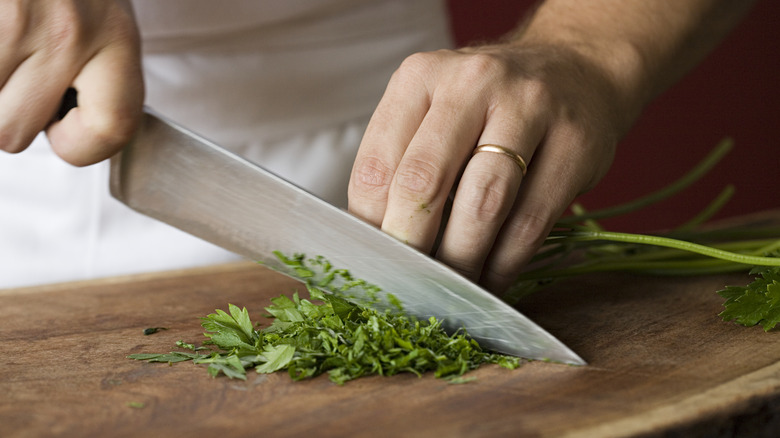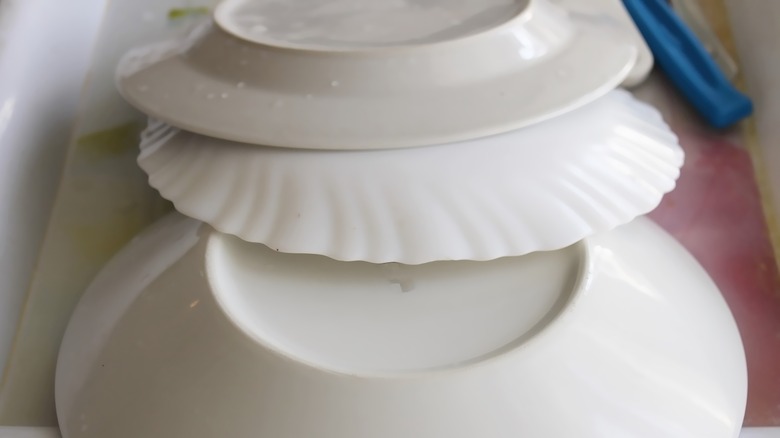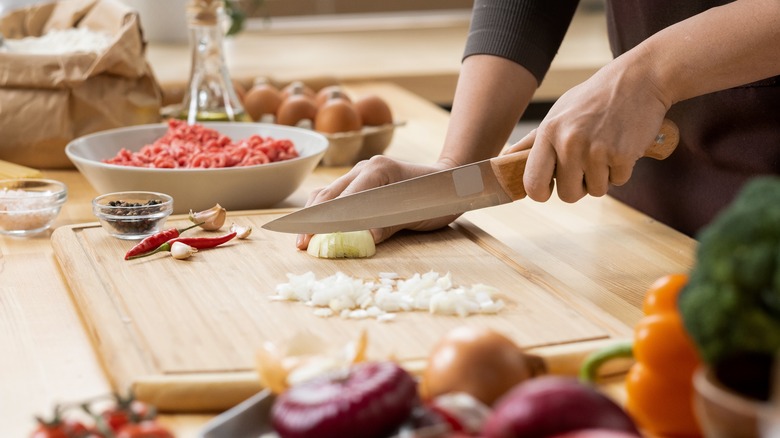The Clever Restaurant Trick To Sharpen Knives With Just A Plate
With today's busy lifestyles, it's rare to find someone who actually takes their kitchen knives in for professional sharpening. Yes, that used to be a thing and still is — just ask the butcher at your local supermarket, and they'll likely do it at no cost. But if you're unlikely to be wielding knives when grocery shopping, there are plenty of home-kitchen sharpeners that get the job done, from electric gadgets to elongated sharpening rods and sharpening stones. Don't have one of those? No worries.
When knives go dull and thwart your slicing and dicing efforts, there's a very simple alternative to dedicated knife sharpeners. It happens to be the same thing that holds your food when seated at the dinner table: a plate. You don't want to use this as a permanent solution, for fear of wearing down that lovely set of dinnerware gracing your dining room. But in a pinch, don't risk harming yourself with a dull knife; just flip a plate upside down and get to sharpening.
If you haven't paid attention before now, there's a ring of ceramic underneath almost every dinner plate that's left unglazed, creating a rough ceramic base that keeps your plate in place on a table and is perfect for sharpening kitchen knives.
Put that unglazed foot ring to work on your knives
In case you're wondering why there's an unglazed "foot ring" beneath a dinner plate, it's because glazing material on the bottom can make the piece stick to the kiln shelf during firing and damage the plate. So, to avoid this, potters typically place the piece on a waxed ring prior to firing it, letting the glaze drip down the sides without touching the bottom.
That unglazed ring is where knife-sharpening magic occurs. Just turn the plate over to expose its bottom, and place it on a sturdy, even surface. Rest one side of the knife's blade against the ring, slightly angled, and gently scrape it. Repeat on the other blade side until it reaches sufficient sharpness to carry on with your cooking. You'll likely notice some thin powdery debris, so run the knife under water to avoid passing ceramic residue into your food.
The process may feel familiar if you've ever used a whetstone for sharpening knives. According the Merriam-Webster, the word "whet" means to sharpen something by rubbing on it, often using a stone. With steel knife blades, this method results in less steel loss during sharpening. Unglazed ceramic on a plate bottom works essentially the same way, using its coarse surface to get your knives in tip-top cutting shape.
And guess what: You can use the bottom of a ceramic mug in exactly the same way. Just flip the mug over and softly grind away dull knife edges.
Dull knives carry serious safety concerns
Other than being just plain annoying to prepare food with a dull blade, there's a serious reason to keep your knives sharpened. It's all about kitchen safety — namely avoiding injuries to your fingers or other body parts when slicing and dicing. You'd think that super-sharpened blades held the most danger, but dull blades can be even worse. Here's why.
Since a dull knife doesn't get cutting jobs done quickly and efficiently, the chef must put more effort into the process, pressing down or carving in awkward ways. That can result in loss of control over the blade, allowing it to slip and cause potentially dangerous injuries. What's worse, the skin cut won't be as clean as one made with a sharper knife, meaning uneven skin tears and potentially worse. Dull knives can also cause sprain injuries to either or both hands because of the excessive force required to cut with them.
Safety first is the name of the kitchen game –– so, by all means, go old-school and flip that plate. It's a simple, efficient, and inexpensive way to keep your kitchen in order with sharp, productive knives.



